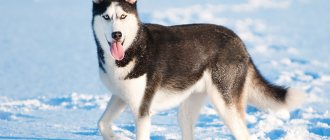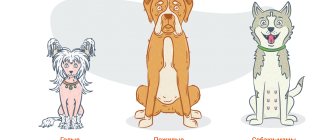In the Russian Federation, dog walking is regulated by a whole range of legal acts. Each region sets its own rules.
In 2021, a new law dated December 27, 2018 No. 498-FZ “On the Responsible Treatment of Animals” came into force, defining not only the general rules for keeping pets, but also the responsibility of their owners. What's new in the new law
The law is designed to regulate the treatment of animals for their protection, safety and rights, and to instill in people humane treatment of their smaller brothers.
In accordance with the new law, the owner of the animal must provide it with proper care and nutrition, timely veterinary care, vaccination, and take measures to prevent the appearance of unwanted offspring. You cannot treat pets cruelly or set them against people or other animals. Organizing fights involving animals is also prohibited.
If for some reason the owner is no longer able to keep the dog, he does not have the right to throw it out into the street. The law obliges the animal to be transferred to another owner, to a shelter or to a veterinary institution.
Current law in Russia
The territory of the Russian Federation is regulated not by one law, but by a system of regulatory legal acts. These include the adopted rules and amendments to them: Federal Law No. 498-FZ dated December 27, 2018 and amendments that entered into force on January 1, 2020. This government decision is based on previously adopted laws of the RSFSR. These regulations clearly indicate the rules for keeping pets and define the area intended for walking pets.
Walking a dog must be carried out according to the rules
Rules for walking dogs in public places
The law does not allow walking with dogs in park areas if there are no fenced areas designated for this purpose. In addition to this ban, walking in the green zone is regulated by internal acts and the Law on Dogs 2019, adopted with amendments coming into force on January 1, 2020.
Violating the law on walking with a pet may result in penalties. In special situations, in addition to administrative liability, criminal liability may be imposed. This type of punishment occurs if the animal has caused serious damage through inaction or with the permission of the owner.
For your information! Legislation and the Ministry of Internal Affairs have created a list of dangerous breeds of pets, according to which the rules for keeping animals in an apartment are even more stringent.
Walking animals must comply with the following rules:
- complete exclusion of the possibility of free or uncontrolled movement of the pet in areas that pose a danger to it. These include the elevator, road, courtyards and common areas of the apartment complex;
- organizing cleanup of the area from animal feces;
- walking only in places provided for this purpose by local government legislation;
- the pet on the list must be dressed in full gear.
An exception to the above rules is walking on private territory belonging to the pet owner. This area must be fenced. There is a text sign on the fence warning about the presence of a potentially unsafe dog. Rules for keeping dogs are a regulatory basis.
List of breeds that can be walked with a muzzle
The bill includes a list of those dogs that cannot be in a public place without a muzzle:
- American Staffordshire Terrier;
- Australian Hog Dog;
- Boerboel;
- Doberman by Vladek Roszyna;
- Dogo Canario;
- Ainu;
- Doberman Pinscher;
- Karelian Bear Dog;
- Superdog and Maykong cross;
- Akbash;
- Purebred Alapaha Bulldog (Otto);
- Languedoc Cattle Dog;
- Uruguayan Cimarron;
- American Bandog;
- East European Shepherd;
- Pit bull mastiff;
- American Pit Bull Terrier;
- Dogue de Bordeaux;
- Neapolitan Mastiff;
- Romanian Shepherd;
- Bull Terrier;
- Moscow watchdog;
- Fila Brasileiro;
- American Bulldog;
- Highland Hound;
- Rhodesian Ridgeback;
- Brazilian Bulldog;
- Irish Wolfhound;
- Leopard Hound;
- Staffordshire Bull Terrier;
- South Russian Shepherd;
- Ambuldog;
- Wolf-dog hybrids;
- German Shepherd;
- Caucasian Shepherd Dog;
- Central asian shepherd dog;
- Belgian Mastiff;
- Shar Pei;
- Anatolian Karabash;
- Kangaroo dog;
- Rafeiro do Alentejo;
- Black Terrier;
- Bullmastiff;
- Greek Shepherd;
- Mallorcan Bulldog;
- Bully Kutta;
- Pyrenean Mastiff;
- English Mastiff;
- Canary dog;
- Daufman Shepherd;
- North Caucasian dog;
- Bandog;
- German dog;
- Dogo Argentino;
- Giant Schnauzer;
- Tuvan Shepherd;
- Gul dog;
- Rottweiler;
- Maremma;
- Tibetan mastiff;
- Cane Corso;
- Tosa Inu;
- Kangal;
- Commander.
Note! If the owner does not use a muzzle, this may result in administrative penalties.
The legislation also stipulates that animals can be walked on areas with an area of at least 400 square meters. There should be no residential buildings in the walking area. Also, the dog should not be near child care institutions (school, kindergarten). If the rules are violated, the owner faces an administrative fine.
Your rating of the article
About large and potentially dangerous dog breeds
Dog walking area: norms and rules
The Russian Ministry of Internal Affairs has created a list of unsafe dog species. This list is approved by law. Dogs and mixed breeds, whose breeds are included in the fighting list, pose a danger due to the presence of a genetic predisposition to aggression and strength.
Note! The list includes Akbashi, several subspecies of bulldogs, and hybrids of wolves and dogs.
Locking up such dogs without walking them is not a solution. These types of fighting dogs are strictly prohibited from free walking, the absence of a muzzle and special control from the owner.
Owners of large dogs whose breed is not included in the list of legally prohibited dogs are also advised to maintain safety.
Dangerous breeds
Which dog breeds need to wear a muzzle?
Full ammunition is necessary for all large dogs, regardless of whether they are on the list of potentially dangerous species. In addition, all dogs that show aggressiveness should be restricted in the muzzle area. Even a small dog can cause serious harm to others. The rules are governed by the Dog Muzzle Act 2021.
Muzzle for dogs
Which dogs can be walked without a muzzle?
According to the regulations of the Russian Federation, breeds that are not on the list of potentially dangerous are allowed to be walked without a muzzle. However, the owner is obliged to be vigilant in any case and prohibit household members from breaking the law.
Important! Full administrative and criminal responsibility for the dog’s habits, its life, and physical condition is ensured by the owner in accordance with the law on muzzles for dogs.
Cannibals? A complete list of dogs that will be prohibited from walking without a leash and muzzle
Photo: pikabu.ru
The document was published on the federal portal of regulatory legal acts. As stated in the explanatory note, the list includes breeds “with genetically determined qualities of strength and aggression, used for bullying.”
In addition, experts added to the list aboriginal breeds, the origin of which is not related to selection for loyalty to humans. In this regard, the behavioral features of such dogs remain insufficiently studied in canine science, experts note.
This list must be approved by the Russian government. The document was developed in connection with the adoption of the Law “On the Responsible Treatment of Animals,” which prohibits walking potentially dangerous dogs without a leash and muzzle anywhere except in a fenced area that belongs to the animal’s owner.
The list of dangerous breeds includes the English Mastiff, American Pit Bull Terrier, Bull Terrier, Boerboel, Staffordshire Terrier, Central Asian Shepherd Dog and some other breeds. Dog-wolf hybrids will also be subject to restrictions.
Samolet offers to get acquainted with all breeds, so to speak, visually.
- Australian wild boar dog.
- Ainu.
- Akabash.
- Akbash.
- American Bandog.
- American Bulldog.
- Ambuldog.
- American Pit Bull Terrier.
- American Staffordshire Terrier.
- Anatolian Karabash.
- English Mastiff.
- Dogo Argentino
- Bandog.
- Belgian Mastiff.
- Dogue de Bordeaux.
- Brazilian Bulldog.
- Bully Kutta.
- Purebred Alapaha Bulldog (Otto).
- Bullmastiff.
- Bull Terrier.
- Boerboel.
- Bandog.
- Wolf-dog hybrids.
- Wolfdog, wolf hybrid.
- East European Shepherd.
- Mountain hound.
- Greek Shepherd.
- Walnut Shepherd.
- Gul dong.
- Doberman by Vladek Roszyna.
- Doberman pinscher.
- Irish Wolfhound.
- Caucasian Shepherd Dog.
- Canary dog (perro de preso canario).
- Dogo Canario
- Kangal.
- Cane Corso.
- Kangaroo dog.
- Commander.
- Karelian Bear Dog.
- Korelian bear dog.
- Languedonian Cattle Dog.
- Leopard hound.
- Mallorcan Bulldog.
- Maremma.
- Moscow watchdog.
- Neapolitan Mastiff.
- German Shepherd.
- German dog.
- Daufman Shepherd.
- Pitbull mastiff.
- Pyrenean Mastiff.
- Rafeiro do Alentejo.
- Giant Schnauzer.
- Rhodesian Ridgeback.
- Rottweiler.
- Romanian Shepherd.
- North Caucasian dog.
- Central asian shepherd dog.
- Staffordshire Bull Terrier.
- Superdog and his cross with Maykong.
- Tibetan mastiff.
- Tosa Inu.
- Tuvan Shepherd Dog.
- Uruguayan Cimarron.
- Fila Brasileiro.
- Black Terrier.
- Shar Pei.
- South Russian Shepherd
- Hybrids of the breeds specified in paragraphs 1–69.
- Mixed breeds of the breeds specified in paragraphs 1-69.
Based on materials from the Internet Samolet
Tweet
Share
Share
Send
Where is it legal to walk your dog?
Dogs are allowed to walk in the following areas:
- near local government bodies assigned to this purpose;
- not classified as home, park, green, children's, playgrounds and sports grounds, forest;
- not belonging to medical, school, or children's organizations;
- not having legislatively and normatively established prohibitions by self-government bodies of any level.
Walking dogs: how many times a day should you walk by time?
The ban on self-walking also applies to the rural sector.
Important! According to the Federal Law, it is prohibited for an owner to walk a dog while intoxicated. Such an owner is not able to give orders in a timely manner and guarantee the safety of the pet, his own and other people and animals.
Where can you walk your dog
This area should be removed or isolated by a fence from public places, especially if they are intended for children (sandboxes, playgrounds). Regardless of the place of walking and the breed, the owner must clean up waste products after the animal. For this purpose, he needs to take a dustpan and a plastic garbage bag outside.
Dogs of non-dangerous breeds are allowed to walk without a muzzle in the following places:
- vacant lots, beams, other green areas;
- equipped sites equipped with reliable fencing;
- suburban parks, if the safety of the people present there is ensured.
Even when in a place permitted for walking, a dog of a dangerous breed must be muzzled. The exception is the territory that belongs to the owner himself and is fenced on all sides, for example, a garden plot next to the cottage.
- Diet for 1 positive blood group
- Makeup for eyes with drooping eyelids
- Types of helminthic diseases
In what places is walking prohibited?
- Courtyards of houses, areas located at a distance of less than 30 meters from the entrances.
- Venues for public events (concerts, holidays, rallies).
- Beaches.
- Cemeteries.
- The territory of medical and educational institutions, cultural and sports institutions.
Is it legal to enter a store or pharmacy with a dog?
According to the laws of the Russian Federation and requirements for dog walking, entry with animals into grocery stores is prohibited. However, there is no mention of non-grocery retail outlets and pharmacies. Nevertheless, the presence of a sign at the entrance prohibiting passage with dogs, as well as requests from employees and store owners to leave the premises if they have a pet, regardless of its size and breed, are a priority for law enforcement officers.
Important! Unimpeded entry into all establishments of a city or town is allowed only to visually impaired people with a guide dog.
Some retail establishments do not oppose visiting customers with pets. A prominent representative of such places are pet stores. But even in them, pets cannot walk independently.
Which dogs are required to wear a muzzle by law?
It is difficult to predict a dog's behavior on the street. An animal can react aggressively to any external irritant, so dog owners should protect others and their four-legged friend using special means. Before you find out which dogs are required to wear a muzzle by law, you need to find out the legal nuances regarding pet walking.
Dog walking rules
When walking, a muzzle not only ensures the safety of others, but also of the dog himself (the possibility of poisoning after eating food from the ground). In the Russian Federation, at the federal level, these issues are regulated by the Federal Law “On the Responsible Treatment of Animals” and amendments to it, in force since January 1, 2018. At the regional level, these activities are controlled by local rules and regulations.
According to these documents, when walking with a pet, owners must follow the basic rules. They are as follows:
If the pet's weight is more than 5 kg, then walking it without a muzzle is prohibited in public places (shops, public transport, public places). Without special devices, the law allows you to walk puppies up to 3 months and dogs with a withers height of no more than 25 cm. In Moscow, this rule applies to all pets, be it a dachshund or a shepherd.
It is necessary to exclude the possibility of free, uncontrolled movement of the animal in courtyards, entrances, elevators, on roads, sports and playgrounds, near schools, kindergartens, clinics and public catering places, using a leash. This applies to pets of all breeds and body weights.
The law allows you to walk your dog around the clock, but silence must be ensured between 11:00 pm and 7:00 am.
It is considered a violation to walk a pet while intoxicated.
By law, the dog’s collar must contain information about the owner’s address and contact information if the animal gets lost.
The dog can be kept without a muzzle and a leash only in specially designated walking areas or in private territory equipped with good fencing and with a sign warning about the presence of the animal.
It is prohibited by law to walk dogs of potentially dangerous breeds without a leash and muzzle. If ammunition is present, then an animal of a dangerous breed should not be accompanied by a minor, a drunk person or a person who does not have a special permit, as well as persons with disabilities or those declared incompetent by a court decision.
The owner is obliged to monitor the cleanliness of the area in which he walks with the dog. If an animal leaves behind waste products, the owner is obliged to remove them with a dustpan and a thick bag.
List of breeds requiring special maintenance
The law prohibits walking pets that require special care without special equipment. Each region has its own list of these breeds. As an example, information on the Moscow region is provided:
Akita; American Bulldog; American Pit Bull Terrier; American Staffordshire Terrier; English Mastiff; Dogo Argentino; Dogue de Bordeaux; Bendog; Brazilian Mastiff (Fila brazelleiro); Bull Terrier; Bullmastiff; Doberman; Caucasian Shepherd Dog; Ca-de-bo; Dogo Canario; Cane Corso; Kuvasz; Moscow watchdog; German Shepherd; German dog; Neapolitan Mastiff (Mastino Neapolitano); Portuguese Shepherd; Giant Schnauzer; Rottweiler; Central asian shepherd dog; Staffordshire Bull Terrier; Tibetan mastiff; Tosa Inu; Chow-chow; Black Terrier; Shar Pei; South Russian Shepherd; Japanese Mastiff.
[yuzo_related]
Responsibility for walking without a muzzle
The law provides for liability for walking a four-legged friend without the necessary equipment in the amount of 2,000 to 4,000 rubles. The amount of the administrative fine varies by region. In Moscow, according to Article 5.1, paragraph 3 of the Moscow Code of Administrative Offenses, punishment for walking dogs without a muzzle in stores, playgrounds, beaches, in transport, near kindergartens, schools, hospitals, clinics and other institutions involved in working with minors, provides for a fine of 1,000 to 2,000 rubles.
Source
Muzzle requirements
There are no clear requirements for the material or size of the muzzle, as is the case with a leash. In order not to harm the animal and not create situations where the dog can simply chew and remove the muzzle, when choosing a device, it is better to rely on the following tips:
- Buy a muzzle that is safe for your dog - completely breathable and allowing the animal in the muzzle to fully open its mouth.
- Select the product by size. The muzzle should not cut into the animal's nose and not interfere with vision. This condition is a guarantee of the safety of others.
Transportation rules
The movement of dogs in transport is permitted only if there are vaccination documents and a certificate of absence of skin diseases, fleas and rabies. The cost of transportation is set by each region individually.
Basic rules when transporting an animal:
- in public transport, in addition to a certificate and paid fare, a muzzle and a leash are required. Small breeds will require a carrier or container;
- There are a number of restrictions on railway transport. Dogs weighing less than 19-20 kg can travel with their owner in a reserved seat or compartment. The owner pays a separate ticket or the cost of baggage transportation, proportional to the weight of the dog. Animals weighing more than 20 kg are transported in specially designated carriages, equipped for the pet’s comfort. Dog care is provided exclusively by the owner and not by train employees;
- Air transport allows dogs weighing less than 8 kg to be transported in the cabin together with the owner. A pet exceeding this mark is located in an insulated luggage compartment with special containers. The dog requires a leash and collar; a muzzle may not be present.
Transportation of pets
Please note! When transporting an animal in a container, there must be a sign with the dog’s name, the owner’s contact information, copies of transportation permits and veterinarian’s reports on the pet’s health.
Dog walking rules
Dog owners must adhere to the following rules .
- In areas intended for walking and training animals, it is allowed to walk dogs without a leash.
- If prohibitory signs are installed at the entrance to a grocery store, the dog must remain nearby on a leash and muzzle. An exception is guide dogs, whose help is used by people with impaired vision.
- The owner should always have special bags or containers with him to clean up after his dog. Recently, people have begun to receive fines for non-compliance with this rule: experts suggest that the “outdoor toilet” of animals contains harmful bacteria and can be a source of parasite infection, including toxocariasis, a disease dangerous for people, especially children.
- When crossing highways and roads, a person must shorten the dog's leash. If an animal unexpectedly jumps out onto the roadway and causes an accident, its owner will need to pay for the treatment of victims and car repairs.
- When traveling on public transport, a person has the right to seat his dog (muzzled and on a leash) in an empty seat. However, he will need to purchase a second ticket for it. You must have with you a veterinary passport containing information about vaccinations, as well as an official form stating that the dog does not have rabies and the date of the last vaccination.
- Small dogs weighing up to 5 kg are allowed to be walked without a leash and muzzle, but if a stranger suffers from the bite of such an animal, the pet owner will need to pay financial compensation.
Disposal of excrement
When walking a dog, the owner is required to collect feces in a bag. To do this, he should always have plastic bags and a scoop with him.
Photo: gavrilovdeniss/ Pinterest
Containers can only be thrown into special dog boxes. Excrement should not be in common containers or mixed with household and food waste.
From the author! Currently, this rule is difficult to implement due to the lack or small number of special containers. There are no fines for throwing bags into general trash cans.
What sanctions are provided for breaking the law?
For ignoring the law, the owner bears civil, administrative and criminal liability. The latter occurs in cases of negligent behavior of the owner in situations in which serious harm to health or death occurs.
Responsibility for the actions of pets
Civil
This type of liability involves the victim’s appeal to the judicial authorities. Claims can be filed according to the standard for:
- damage to personal and public property;
- harm to physical health;
- causing moral harm or psychological trauma.
The legislature may award compensation for both material and moral damages.
Note! Responsibility lies directly with the owner of the dog, and not with the person accompanying it at the time of the violation. Without knowing the rules, you cannot avoid responsibility.
Administrative
It involves imposing sanctions on the dog’s owner for violations committed by his pet. Administrative liability may arise for the following reasons:
- disturbance of peace at night and in the wrong place according to the law on silence;
- walking and uncontrolled presence of a pet in a closed area;
- environmental pollution from dog waste products;
- walking a pet without a muzzle or leash from the list of dangerous breeds.
For your information! The amount of monetary compensation is determined by local governments, so the amount of the fine may vary.
Responsibility: procedure for involvement and basis
For walking pets in the wrong place or being with them without a muzzle, the owner bears civil, administrative and criminal liability. Punishment under criminal article 119 of the Criminal Code of the Russian Federation will be imposed if the animal owner’s failure to comply with the laws has resulted in serious harm to health or death.
Civil responsibility
The injured party may file a claim with the courts. Most often the subject of dispute is:
- damage to personal and public property;
- causing minor harm to health;
- infliction of psychological trauma, moral harm.
Based on the results of consideration of the claim, the judge may award compensation for moral and material damage.
Important ! In accordance with legal practice, the owner is responsible for all actions of the pet and the consequences, and not the person who accompanied the animal at the time of the incident.
For failure to comply with the rules for walking animals, the owner faces an administrative fine
Administrative
Such responsibility implies the issuance of fines in accordance with the Code of Administrative Offenses. An administrative form of liability occurs in the following cases:
- the dog disturbs the peace at night;
- the dog is walked without supervision in a closed area;
- environmental pollution with pet excrement products;
- going out with a pet that is on the list of dogs prohibited from walking without a muzzle or equipment.
If a dog is muzzled while walking, but at the same time it damages green spaces in the park, the owner faces a fine.
The amount of administrative fines depends on the regions. For example, on the basis of Law No. 45 of the city of Moscow “Code of the City of Moscow on Administrative Offences”, Article 5.1 establishes the following dimensions:
- Violation of the dog walking rule - a fine of 1,000 to 2,000 rubles.
- Allowing an animal to attack another animal (even a cat) – from 4,000 to 5,000 rubles.
- Causing damage to property - from 2,000 to 3,000 rubles for individuals, from 6,000 to 10,000 rubles for officials.
If neighbors see a situation where the dog’s owner is negligent in keeping him, violating the rules of walking, you can file a complaint with the district police officer or the local administration. The application can be written individually or made as a collective appeal on behalf of all neighbors. If no action is taken on the complaint, the applicant has the right to appeal to the judicial authorities or the prosecutor's office.
Compliance with the requirements for keeping pets and walking in accordance with all legal norms will not only help you avoid fines, but will also ensure the safety of both the dog and those around you.
Teach commands
The pet must clearly understand basic commands. So that if necessary, your prohibition would be enough to calm the dog. Among the main required commands:
- "near";
- "to me";
- "ugh";
- "sit".
The animal must understand and follow commands the first time.
A dog's behavior is the result of human upbringing. Therefore, the owner bears full responsibility for the actions of his four-legged friend. If you start instilling certain norms in your puppy from an early age, it will not be difficult for him to strictly follow them in the future.
Where to complain about violators
In case of neglect of a pet, as well as for non-compliance with the law on keeping dogs, victims can contact the local administration or the local police officer. The application can be submitted either individually or as a collective complaint. If the decision on the application does not satisfy the plaintiff, he has the right to file a claim or a new application to the prosecutor's office or court.
Only proper maintenance of a pet, in accordance with the legislation of the Russian Federation, will protect the animal from cruel treatment, and its owner from the imposition of civil, administrative or criminal liability.
Dog fighting
Organizers, as well as participants in dog fighting, bear criminal liability under Art. 245 of the Criminal Code of the Russian Federation “Cruelty to animals”. The minimum penalty for the crime is a fine of 80 thousand rubles, the maximum is imprisonment for up to three years.
Since this act involves a public demonstration, the fine can be increased to 300 thousand rubles, and the term of imprisonment - up to five years.











